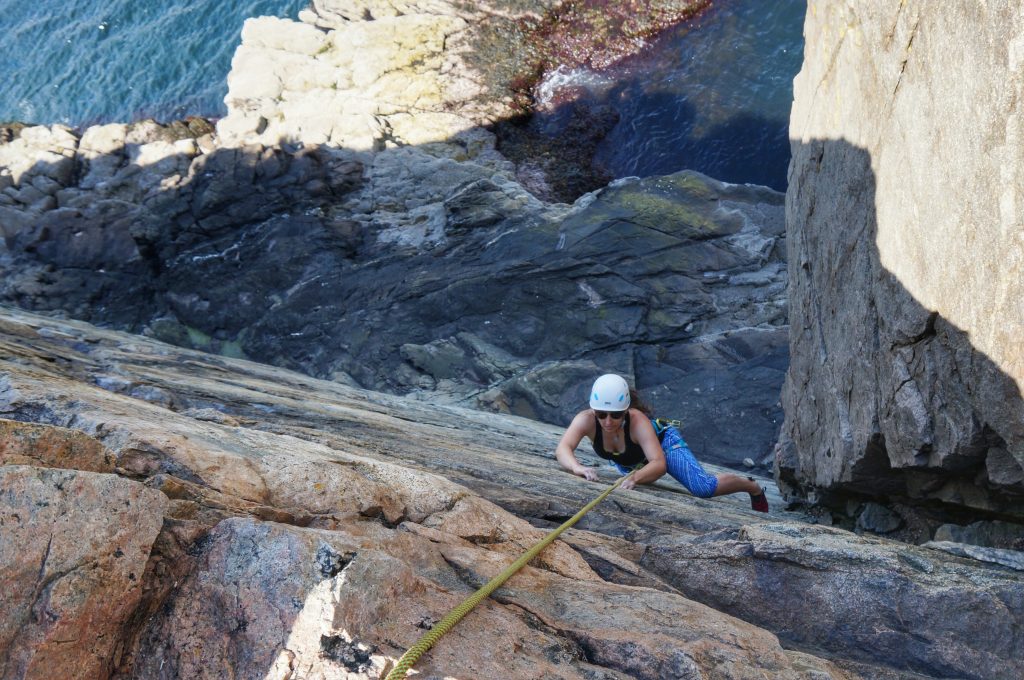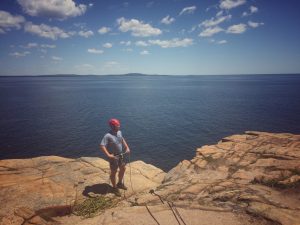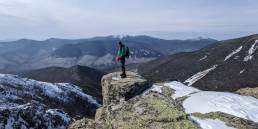From the Precipice to the Bubbles to Great Head, Acadia National Park is full of great climbing destinations. But, in spite of all the fantastic spots, one place stands out among the rest: Otter Cliffs.
While New England may offer many larger and more imposing walls, nothing compares to climbing on this relatively small crag. Rising roughly 60 feet out of the ocean, this collection of compact granite cliffs provides incredible rock, fun routes, and one of the most picturesque and unique climbing experiences anywhere.
In addition to the Instagram-worthy setting of Otter Cliffs, there is something incredibly exciting and intimidating about the moment you commit yourself to the climb and either rappel or get lowered down to the lapping waves below.
From the bottom, the walls look steeper than they did at the top, even on the crag’s moderate routes. After pulling yourself onto the rock, you quickly realize that this isn’t Cathedral granite or Rumney schist. Although the walls are composed of granite, the ocean’s tides, waves, and mist make the first few moves of most Otter Cliffs routes pretty spicy, with damp, greasy hand-holds and slick feet.

Another thought occurs when you arrive at the bottom of the cliff: You’re committed.
While commitment is something all climbers face, there is an unnerving feeling exclusive to being at the bottom of a sea cliff. Despite being a climber accustomed to all of these uncomfortable positions, you sense something powerful about the ocean under your shoes, the tide rising, and the knowledge that the only way up is to climb.
Well…In all honesty, climbing isn’t really the only way up. However, it is, perhaps, the most convenient and certainly the most dignified way back to the top. While Otter Cliffs provides such an experience, it also presents a unique set of challenges and requires a different set of skills from most of the other popular New England crags.
Getting There
If its seaside location, amazing routes, and impeccable granite weren’t enough to entice you, the approach will, as the crag is less than a five-minute walk from Park Loop Road. To find it, just follow the hiking path on the ocean side of the road and look for the climber’s path leading to the cliff.
If you are there during the busy season of July and August, you’ll very likely hear the climbers before seeing them. Before reaching the cliff, you will encounter a climber registration box — don’t forget to sign in, as it helps the National Park Service monitor climbers’ use of the area.
Setting Up
 During the height of Acadia’s climbing season, the top of Otter Cliffs can resemble a spider web, as numerous parties will have anchors strewn across. While there are some fixed anchors available, many of Otter Cliffs’ climbs require a gear anchor. It’s also worth noting that due to the heavy use this cliff sees, building anchors using trees is frowned upon. If you aren’t familiar with building your own anchors, brush up on your skills with a lesson from EMS Climbing School.
During the height of Acadia’s climbing season, the top of Otter Cliffs can resemble a spider web, as numerous parties will have anchors strewn across. While there are some fixed anchors available, many of Otter Cliffs’ climbs require a gear anchor. It’s also worth noting that due to the heavy use this cliff sees, building anchors using trees is frowned upon. If you aren’t familiar with building your own anchors, brush up on your skills with a lesson from EMS Climbing School.
As you learn about gear anchors, you can also brush up on other skills valuable to Acadia-bound climbing, such as top-down belaying and hauling. As a side note, there is also a good chance one of our AMGA-certified guides can give you a few pro tips, such as the island’s best routes, places to camp, and spots to grab a beer.
Route Favorites
The Great Chimney is perfect for warming up and getting acquainted with the island’s climbing, as it’s rated a beginner-friendly 5.5. But, don’t let that fool you: Even experts appreciate climbing this stunning location, as this route ascends the chimney between a freestanding sea stack and Otter Cliffs themselves.
Climbers looking to push themselves a little harder need only to move over a few climbs to the Yellow Wall. Moderately graded at 5.8, this spot is known for a yellow lichen-covered arete, hence its name. This route places climbers on the wall’s edge, only increasing the exposed feeling of climbing above the crashing ocean beneath you.
Climbers interested in trying a local test piece need only look few climbs over from Yellow Wall to Guillotine. I have seen it graded anywhere from 5.10a to 5.10b to 5.10-, but it has always felt harder than that to me. Forcing climbers to use all their tricks, Guillotine begins at the wide crack around the arete from Yellow Wall. As you ascend, follow the route’s small face holds and thin cracks while attempting to conserve enough energy for the pump-like crux at the roof. If you manage to cruise the crux, you’ve exceeded my ability and are welcome to leave your grading recommendation in the comments.
By tackling its great routes, ascending its amazing rock, and seeing a one-of-a-kind location, most Otter Cliffs climbers won’t even care that they one-hung Guillotine, because it gives them an excuse to go back and try again.
Tim Peck
A former child model, Tim spent a portion of his youth gracing the pages of Sunday paper advertisements for many now-defunct department stores. Living responsibility/rent-free with his parents into his thirties, Tim pursued climbing, skiing, and biking while accumulating an impressive amount of time in the mountains (and gear). Now almost grown up, he lives in central New Hampshire with his wife, Australian Shepherd, and cat. Relentlessly pursuing the dream, Tim's modest life ambitions are to ski all 12 months of the year, climb 5.12, and live in a van.
Related Posts
April 12, 2024
Explore Like a Local: The Outdoor Mecca of North Conway, NH
There's a lot to love about this New…
April 3, 2024
5 Things To Do in the Boston Area During Mud Season
Adventure opportunities are abundant…
2 Comments
Comments are closed.





Building anchors using trees is not only frowned upon at Otter, it is not allowed by the park. https://www.nps.gov/acad/planyourvisit/climbing.htm
[…] If you’re looking for other things to do while in Acadia, our “First-Timer’s Guide to Acadia National Park” has you covered. Make sure to check out the tide pools, the Beehive Trail, and Otter Cliffs. […]